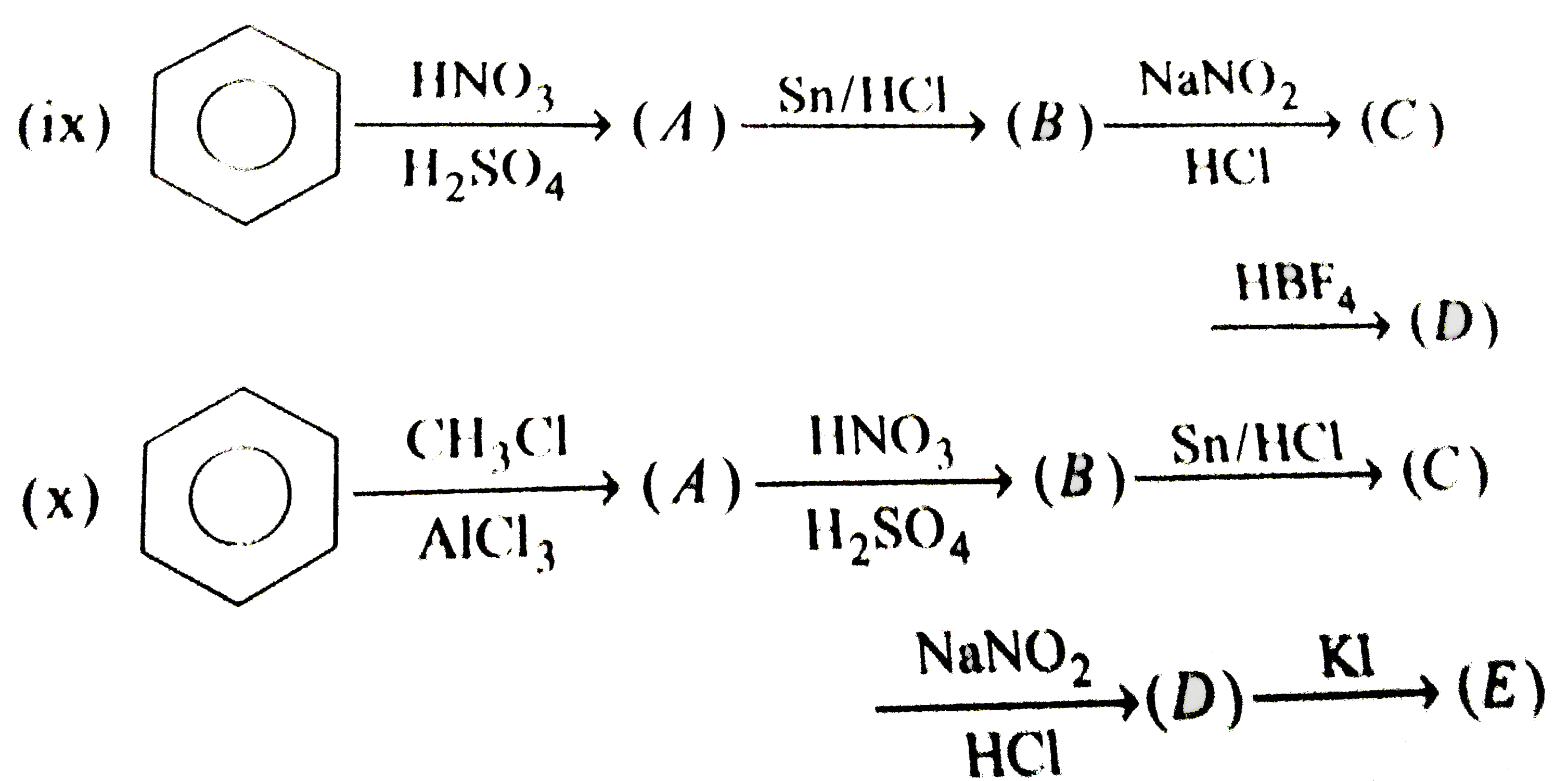Idetify A,B, C, …..
CH3CHOPCl5−−→Aaq.KOH−−−−→BNaOH−−−→Cl2C(l)+D(aq.)
To solve the given problem step by step, we will identify the compounds A, B, C, and D based on the reactions described.
Step 1: Identify Compound A
We start with the compound CH₃CHO (acetaldehyde) and react it with PCl₅.
1. Reaction with PCl₅:
- Acetaldehyde has a carbonyl group (C=O) which can react with PCl₅.
- The phosphorus pentachloride will convert the carbonyl group into a chlorinated product.
- The reaction will yield CH₃C(Cl)(O)(Cl)(Cl)(Cl), which simplifies to CH₃C(Cl)(O)Cl after the reaction stabilizes.
Thus, Compound A = CH₃C(Cl)(O)Cl (2-chloroacetaldehyde).
Step 2: Identify Compound B
Next, we treat compound A with aqueous KOH.
2. Reaction with Aqueous KOH:
- The hydroxide ion (OH⁻) acts as a nucleophile and attacks the carbon atom bonded to chlorine.
- Since there are two chlorine atoms, the nucleophilic substitution will occur twice.
- The final product will be CH₃C(OH)(OH) (2-hydroxyacetaldehyde).
Thus, Compound B = CH₃C(OH)(OH).
Step 3: Identify Compound C
Now, we react compound B with Cl₂ in the presence of NaOH.
3. Haloform Reaction:
- The presence of the hydroxyl group (C-OH) and the methyl group (C-CH₃) allows for a haloform reaction.
- The reaction will convert the compound into CHCl₃ (chloroform) and D (sodium acetate or sodium hydroxide).
Thus, Compound C = CHCl₃ (chloroform).
Step 4: Identify Compound D
Finally, we identify compound D.
4. Compound D:
- Since we have reacted B to form C, the byproduct in aqueous solution will be D = CH₃COONa (sodium acetate).
Thus, Compound D = CH₃COONa.
Summary of Compounds
- A = CH₃C(Cl)(O)Cl (2-chloroacetaldehyde)
- B = CH₃C(OH)(OH) (2-hydroxyacetaldehyde)
- C = CHCl₃ (chloroform)
- D = CH₃COONa (sodium acetate)
We start with the compound CH₃CHO (acetaldehyde) and react it with PCl₅.
- Acetaldehyde has a carbonyl group (C=O) which can react with PCl₅.
- The phosphorus pentachloride will convert the carbonyl group into a chlorinated product.
- The reaction will yield CH₃C(Cl)(O)(Cl)(Cl)(Cl), which simplifies to CH₃C(Cl)(O)Cl after the reaction stabilizes.
Next, we treat compound A with aqueous KOH.
- The hydroxide ion (OH⁻) acts as a nucleophile and attacks the carbon atom bonded to chlorine.
- Since there are two chlorine atoms, the nucleophilic substitution will occur twice.
- The final product will be CH₃C(OH)(OH) (2-hydroxyacetaldehyde).
Now, we react compound B with Cl₂ in the presence of NaOH.
- The presence of the hydroxyl group (C-OH) and the methyl group (C-CH₃) allows for a haloform reaction.
- The reaction will convert the compound into CHCl₃ (chloroform) and D (sodium acetate or sodium hydroxide).
Finally, we identify compound D.
- Since we have reacted B to form C, the byproduct in aqueous solution will be D = CH₃COONa (sodium acetate).
- A = CH₃C(Cl)(O)Cl (2-chloroacetaldehyde)
- B = CH₃C(OH)(OH) (2-hydroxyacetaldehyde)
- C = CHCl₃ (chloroform)
- D = CH₃COONa (sodium acetate)
Similar Questions
Knowledge Check
- Question 1 - Select One
Identify Z in the reaction ?
CH2Cl2aq. KOH−−−−→XCH3Mgl−−−−−−−→H2OY(O)−−→ZACH3−OHBCH3−CH2OHCCH3CHODHCHO
Identify A,B,C, and D
C2H5Br+KOH(aq)→[A]CaOCl2−−−−→[B]Ag−−→[C]Hg2+−−−→H+[D]View SolutionWrite the structures of A, B and C in the following:
(i) C6H5CONH2Br2/aq.KOH−−−−−−−−→ANaNO2/HCl−−−−−−−−−−→0−5∘CBKI−−→C
(ii) CH3ClKCN−−→ALiAlH4−−−→BCHCl3+alcKOH−−−−−−−−−−−−−→ΔCView SolutionIn a series of following reaction the end product 'C' is
C2H5OHPCl5−−→Aaq.KOH−−−−→BSOCl2−−−→CView SolutionComplete the following by providing (A),(B),(C) and (D) :
(i)CH3CH2CH2OHPBr−−→(A)alc.KOH−−−−−−→Δ
(B)HBr−−→(C)NH3−−→(D)
(ii)CH3CH2CH2Ialc.KOH−−−−−−→Δ(A)H+/H2O−−−−−→
(B)SOCI2−−−→(C)H−−−−−−→LiAIH4(D)
(iii)CH3CHBrCH3alc.KOH−−−−−−→Δ(A)HBr−−−−−−−→Peroxide
(B)Nal−−−−−−→Acetone(C)H−−−−−→Ether
(iv)CH3CH2CH=CH2NBS−−−−−→Light(A)alc.KOH−−−−−−→Δ(B)
HBr−−→(C)
(v)CH3CH2MgBrCH3CHO/H2O−−−−−−−−−→(A)HBr−−→(B)
alc.KOH−−−−−−→Δ(C)
(A)NH3−−→(B)CHCI3+KOH(alc.)−−−−−−−−−−−−−→(C)Na−−−−−−−→C2H5OH
CH3−C∣CH3H−NHCH3

(viii)CH3CH2Br(i)(CH2)6N4−−−−−−−−−−−→(ii)H2O/H+(A)NaOH−−−→(B)
(i)O3−−−−−−−−−−−→(ii)Zn/HOH(A)+(C)conc.NaOH−−−−−−−→(D)
 View Solution
View SolutionCH3CH2CHCI2Aq.KOH−−−−−→?
View SolutionGive the structures of A,B and C in the following reactions :
(i) CH3BrKCN−−→ALiAlH4−−−→BHNO2−−−−−−→273KC
(ii) CH3COOHNH3−−−−−→ΔABr2+KOH−−−−−−→BCHCl3+NaOH−−−−−−−−−→C
(iii) CH3CNH2O/OH−−−−−−−→ANH3−−−−−→ΔBBr2+KOH−−−−−−→CView SolutionComplete the missing links in the following
(i). CH3CH2CH2OHPBr3−−→[A]alc.KOH−−−−−→[B]HBr−−→[C]NH3−−→[D]
(ii). CH3CH2CH2Ialc.KOH−−−−−→[A]H+/H2O−−−−−→[B]SOCl2−−−→[C]LiAlH4−−−→[D]
(iii). CH3CHBrCH3alc.KOH−−−−−→[A]HBr−−−−→Peroxide[B]NaI−−−−→Acetone[C]Mg−−→Ether[D]View Solution

